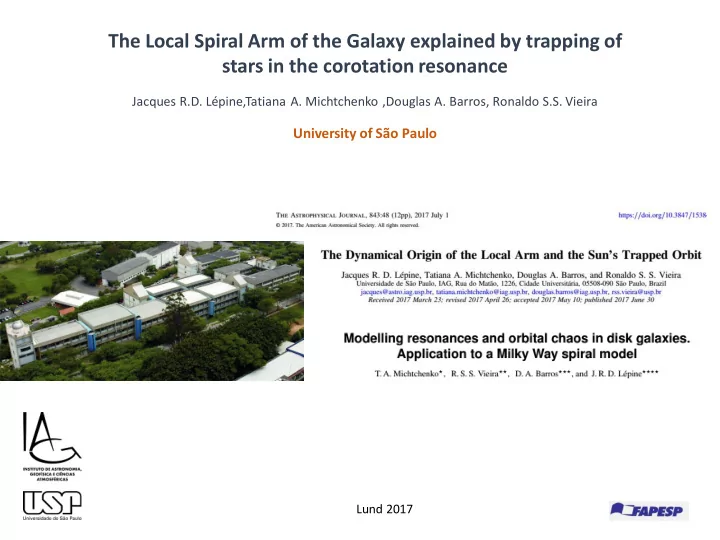

The Local Spiral Arm of the Galaxy explained by trapping of stars in the corotation resonance Jacques R.D. Lépine,Tatiana A. Michtchenko ,Douglas A. Barros, Ronaldo S.S. Vieira University of São Paulo Lund 2017
Basics of the model 1) Totally observationally constrained, based on generally accepted description of the gravitational potential of the local region of the galaxy φ = φ 0 + φ 1 disk + spiral arms perturb. 2) Use objects with precise distance, proper motion and radial velocity to integrate their orbit (masers observed with VLBI) 3) Work in frame of reference rotating with the spiral arms 4) integrate the orbits and discover librating stars in the local arm
Φ 0 potential of the disk (potential of the Galaxy) • The rotation curve is observable; it gives direly the force acting on the stars We avoid to use models and discussions about what is the contribution of a dark halo or any other component. • The results of the present model do not depend on taking into account or not the local dip Barros et al. 2016 A&A
φ 1 Spiral Arms What is the best mathematical description of a spiral arm? A.J. Kalnajs (1973) ideas explain the arms And show that they are potential valleys Gas and stellar spiral arms and their offsets in the grand-design spiral galaxy M51 Fumi Egusa Erin Mentuch Cooper Jin Koda Junichi Baba MNRAS , Volume 465, Issue 1, 11 February 2017, Pages 460 – 471,
Potential perturbation of the arms Two-armed Logarithmic Gaussian Potential Junqueira et al. 2013, A&A 550, A91 In the present work m = 4 Reference frame of ϕ = θ – Ω p t spiral arms 𝝔 𝟐 ( R , φ) = 𝝔 𝑬 𝒇 𝒋[𝒏𝝌+𝒈 𝒏 𝑺 ] Classical 𝑺 𝟑 [𝟐 − 𝐝𝐩𝐭(𝒏𝝌 − 𝒈 m ( R ))]- ϵ s R - k ⃓ z ⃓ ] 𝝔 𝟐 ( R , φ, z) = - ζ 0 R 𝒇𝒚𝒒[− 𝝉 𝟑 Junqueira´s
Where are the arms? How many arms? 4 arms is the best fit!
Vallée 2014 Tangential directions Potential of the disk removed, only perturbation Shown, with negative potential (arms are positive)
Pattern speed Last parameter to be decided: Ω p Ω p = V c / R C Rotation curve ~ 28. 4 km/s/kpc = 230 km/s / 8.1 kpc
The same physics and equations of the Lagrangean points L4 and L5 where the Trojan asteroids are trapped in the orbit of Jupiter. Trojan asteroids
Size of corotation zone depends on spiral arm strenght
What objects to use to test the model? (waiting for GAIA DR2) Methanol Masers associated with massive stars, short lifetime, not able to move away from their birthplace Paralaxes typically of the order of 1 mas For distances of 2 kpc typically errors are of the order of 0.2 kpc Errors in velocities in the U, V components typically 5 km/s We adopted R0 = 8 kpc Vo= 230 km/s, within the determination by Schoenrich 2012 (MNRAS) R0 = 8.27± 0.029 kpc and V0= 238 ± 9 km/s The results found in this work are robust. Small changes in R0 , V0, pitch angle, strength of the arms, do not change the existence of a corotation zone
The dynamical map of the corotation zone. Stars in clear regions have stable orbits, dark regions are regions of chaotic orbits. Masers in red color
+ Masers that librate (allways stay in the corotation zone) + Masers that will circulate in the Galaxy (Some masers from other references where added)
Observed consequences Circulation of stars Minimum of U velocity at corotation Metallicity of Young stars The dip in the rotation curve
Circulation
Sample of Cepheids (available from Vizier ) Average of modulus of U component of velocity and dispersion rms of U component of velocity 40 30 20 10 4 6 8 10 12 14 16 4 6 8 10 12 14 16 We defined U as the velocity in the galactic radial direction. The circular rotation of the stars does not affect the motion in the radial direction. The minimum at 8 kpc is due to The trapped stars.
Galactic Radial gradient of metallicity from very Young objects Dramatic drop of about 4 dex at 9 kpc - but not really “ galactic Radial” The Gaia -ESO Survey: the present-day radial metallicity distribution of the Galactic disc probed by pre-main-sequence clusters , L.Spina et al ., A&A 601, A70 (2017) (Sao Paulo Univ.)
Azimuthal gradient of metallicity Sample of Cepheids Azimuth measured from Galactic center Angle 0 = Direction of anticenter Analysed: ring from 7 to 9 kpc [Fe/H]-[Fe/H]solar Inside corotation stability zone the metallicity is higher
The dip 1) an example of the deep seen by other authors • Blue: HII and CO • Magenta: masers • Green: Masers that are liberating In the corotation zone But it is not a “galactic “ dip, only local
Conclusions Many stars of the solar vicinity and tracers of the Local Arm are trapped in a banana-shaped island of stability around the Lagragian point L4 The results that we obtained are robust, as they remain practically the same if we perform small changes in the adopted parameters of the Galaxy, within the accepted range of uncertainties. With the parameters adopted, the Sun is also trapped! We believe that from now on, it will be impossible to ignore the corotation zone, to correctly interpret stellar orbits in the solar vicinity, metallicity gradients, etc. Future with Gaia LSR? Moving groups? Much more!
Recommend
More recommend